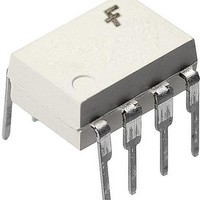FSL126HR Fairchild Semiconductor, FSL126HR Datasheet - Page 10

FSL126HR
Manufacturer Part Number
FSL126HR
Description
Power Switch ICs - POE / LAN Green Mode Fairchild Power Switch (FPS)
Manufacturer
Fairchild Semiconductor
Datasheet
1.FSL126HR.pdf
(13 pages)
Specifications of FSL126HR
Number Of Switches
Single
On Resistance (max)
6.2 Ohms
On Time (max)
23 ns
Off Time (max)
17.2 ns
Supply Voltage (max)
26 V
Maximum Operating Temperature
+ 105 C
Minimum Operating Temperature
- 40 C
Package / Case
DIP-8
Maximum Power Dissipation
1.5 W
Mounting Style
Through Hole
Operating Frequency
100 KHz
Switch Configuration
Single
Switch Current (typ)
1.5 A
Lead Free Status / Rohs Status
Details
© 2011 Fairchild Semiconductor Corporation
FSL126HR • Rev. 1.0.0
Overload Protection (OLP)
Overload is defined as the load current exceeding a pre-
set level due to an unexpected event. In this situation,
the protection circuit should be activated to protect the
SMPS. However, even when the SMPS is operating
normally, the overload protection (OLP) circuit can be
activated during the load transition or startup. To avoid
this undesired operation, the OLP circuit is designed to
be activated after a specified time to determine whether
it is a transient situation or a true overload situation.
In conjunction with the I
current-mode feedback path limits the current in the
SenseFET when the maximum PWM duty cycle is
attained. If the output consumes more than this
maximum power, the output voltage (V
below its rating voltage. This reduces the current
through the opto-coupler LED, which also reduces the
opto-coupler transistor current, thus increasing the
feedback voltage (V
feedback input diode is blocked and the 5µA current
source (I
this condition, V
the switching operation is terminated, as shown in
Figure 18. The shutdown delay is the time required to
charge C
Figure 17. Auto-Restart Protection Waveforms
Figure 18. Overload Protection (OLP)
DELAY
FB
from 2.4V to 6V with 5µA current source.
) starts to charge C
FB
increases until it reaches 6V, when
FB
PK
). If V
current limit pin (if used), the
FB
FB
exceeds 2.4V, the
slowly up to V
O
) decreases
CC
. In
Abnormal Over-Current Protection (AOCP)
When the secondary rectifier diodes or the transformer
pin are shorted, a steep current with extremely high di/dt
can flow through the SenseFET during the LEB time.
Even though the FPS has OLP (Overload Protection), it
is not enough to protect the FPS in that abnormal case,
since severe current stress is imposed on the
SenseFET until OLP triggers. The FPS includes the
internal AOCP (Abnormal Over-Current Protection)
circuit shown in Figure 19. When the gate turn-on signal
is applied to the power SenseFET, the AOCP block is
enabled and monitors the current through the sensing
resistor. The voltage across the resistor is compared
with a preset AOCP level. If the sensing resistor voltage
is greater than the AOCP level, the set signal is applied
to the latch, resulting in the shutdown of the SMPS.
Thermal Shutdown (TSD)
The SenseFET and the control IC are integrated,
making it easier to detect the temperature of the
SenseFET.
approximately 137°C, thermal shutdown is activated.
Over-Voltage Protection (OVP)
In the event of a malfunction in the secondary-side
feedback circuit or an open feedback loop caused by a
soldering defect, the current through the opto-coupler
transistor becomes almost zero. Then, V
a similar manner to the overload situation, forcing the
preset maximum current to be supplied to the SMPS
until the overload protection is activated. Because
excess energy is provided to the output, the output
voltage may exceed the rated voltage before the
overload protection is activated, resulting in the
breakdown of the devices in the secondary side. To
prevent this situation, an over-voltage protection (OVP)
circuit is employed. In general, V
output voltage and the FPS uses V
monitoring the output voltage. If V
circuit is activated, resulting in termination of the
switching operation. To avoid undesired activation of
OVP during normal operation, V
to be below 24V.
10
Figure 19. Abnormal Over-Current Protection
When
the
temperature
CC
CC
CC
CC
is proportional to the
should be designed
exceeds 24V, OVP
instead of directly
FB
www.fairchildsemi.com
climbs up in
exceeds











